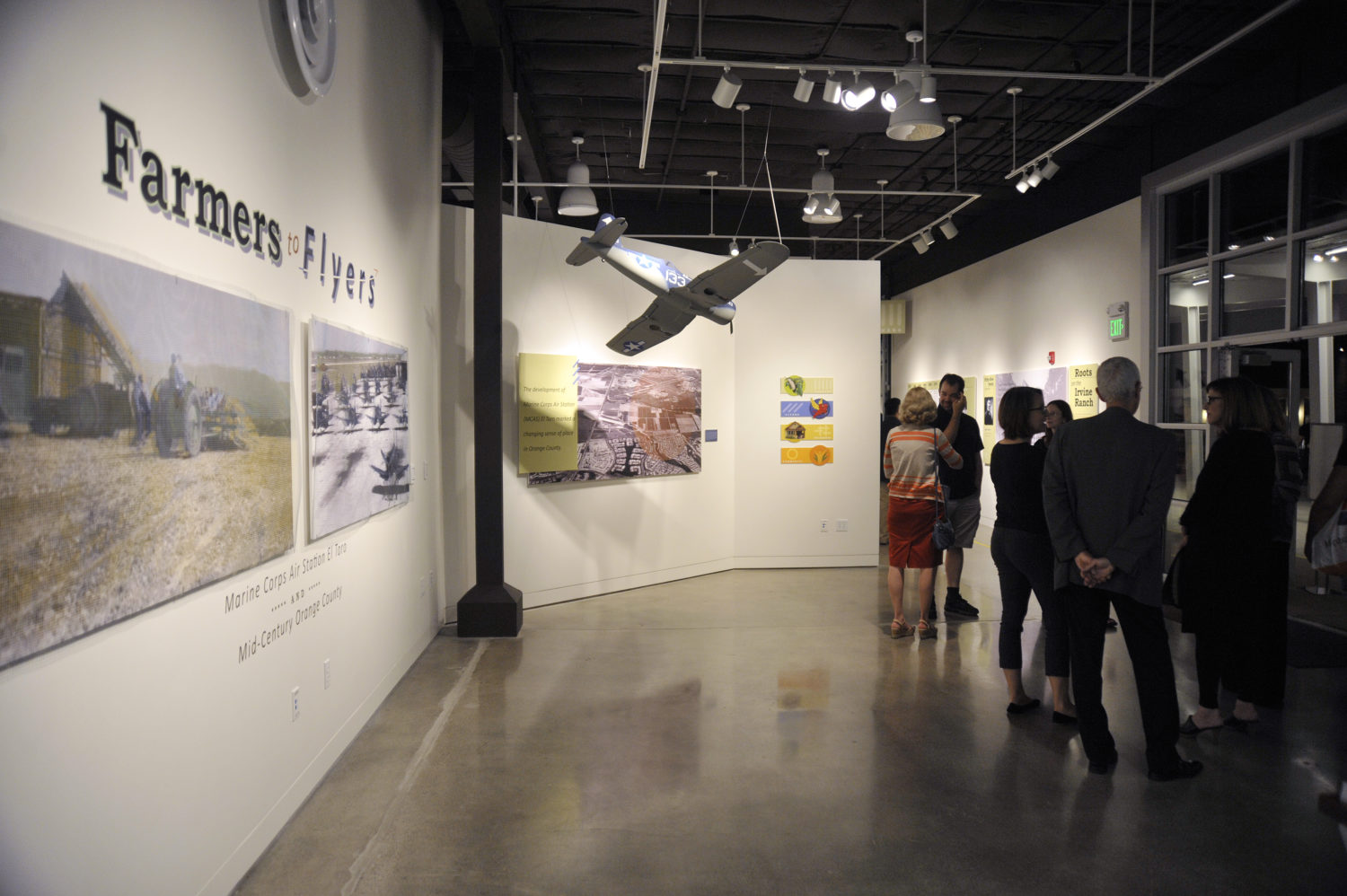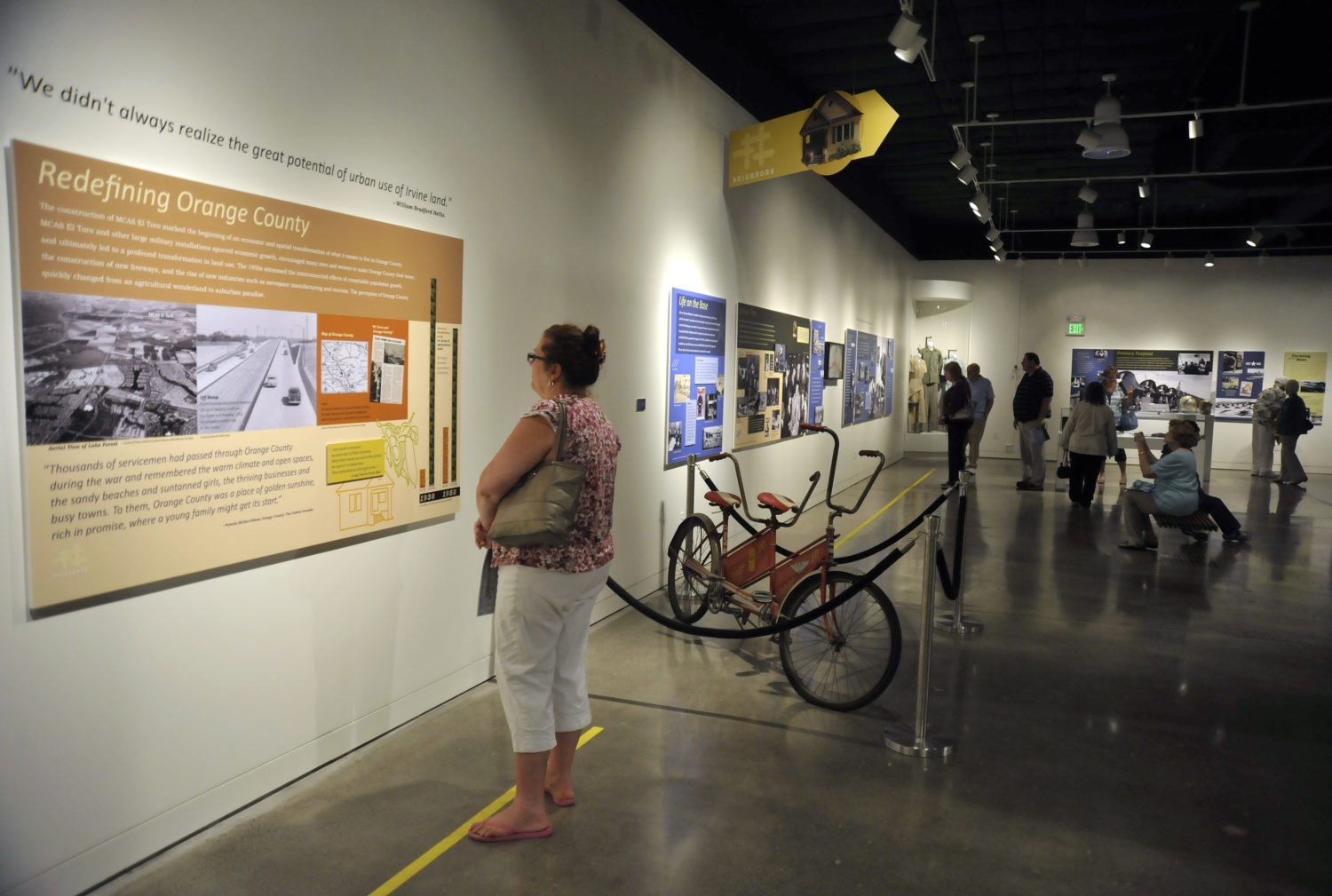Since its 2011 opening, Irvine’s Great Park Gallery has presented a variety of provocative exhibitions, many of them aviation related, with others exploring various aspects of contemporary art.
While the gallery is now closed, a look back at its 2012 aviation related show, “Farmers to Flyers: Marine Corps Air Station El Toro and Mid-Century Orange County,” reveals the gallery’s devotion to intensive research, to historical accuracy and to alluring presentation of its art pieces and supporting memorabilia.
Displayed from September 2012 to March 2013, “Farmers to Flyers” was comprised of historical photos, videos, oral histories, documents and artifacts, detailing MCAS El Toro’s impact on Southern California. It was curated by Henry Korn, formerly Manager, Arts, Culture and Heritage at the Great Park.

Photo by the Orange County Great Park
I visited this exhibition shortly after it opened and was fascinated by its extensive presentation, documenting the history of Orange County and of MCAS El Toro. I wrote a review of the show for a publication that has morphed into another entity. The information contained within my review brings to light how relevant and important our county’s history continues to be. Here is my review:
“Farmers to Flyers: Marine Corps Air Station El Toro and Mid-Century Orange County” tells the story, in pictures, words, video and sculpture, of how the O.C. grew in a century and a half from vegetable fields and citrus orchards to a Marine air base, and ultimately to a bursting-at-the-seems megalopolis. This exhibition was created in part from 400 interviews with El Toro veterans, conducted by the Center for Oral and Public History at Cal State Fullerton. This show’s initial display documents in photographs and words the agrarian nature of Orange County of the 19th and early 20th centuries. Here are descriptions of the massive Irvine Ranch and of three members of the Irvine family who ran that successful empire. Also profiled is Japanese-American Roy Sakioka who settled and farmed in Orange County, was later interned at Manzanar Internment Camp, and then returned to his farm, eventually moving on to working as a successful real estate developer. Here are displays about the proliferation of citrus crops and their scenic fruit box logos, each a work of art itself.
The core of this exhibition is the development of MCAS El Toro (carved out of land originally owned by the pioneer farmers). Along with the requisite accounts of military training and paraphernalia are portrayals of life on this base, as this city within a city was occupied by hundreds of thousands of marines and their families over decades. These depictions include visuals and stories about the schools, playgrounds, churches, dances, performances, sports teams, beach outings and shopping at the base “shopping mall” for military gear, pots and pans, women’s and children’s clothing and more. Particularly informative are panels about female Marines, handsome in their uniforms, working on aircraft and engaging in team sports. There are also written accounts by Marines from disparate parts of the country about the bucolic base, the perfect weather, the orange scented air and the nearby farmland.

Photo by the Orange County Great Park
The exhibition explains that Orange County’s massive expansion, starting in the 1960s and continuing to the present day, occurred partly due to many of the service people who resided at El Toro, who loved the area and eventually settled here. Adding to this human influence was the considerable amount of land developed into tract housing, business and shopping centers all over the county, and the construction of a major university and one famous amusement park. Here is a picture of President Johnson at a University of California, Irvine dedication in 1964; another of a family moving into the first Mission Viejo Company home in 1967; one of Disneyland being constructed in the 1950s; and a shot of OC native President Richard Nixon landing at El Toro Marine Base during the Vietnam War. To this exhibition’s credit, a few panels are devoted to the emergence here of the ultra-right wing John Birch Society.
The final portion of this show is about the closing of MCAS El Toro in the 1990s, about its proposed changeover to an airport, the ensuing battle with residents about its fate, and the citizens’ vote to turn the base into a park in 2002. Implicit in this final display is that it is to Orange County’s credit that this Great Park is even being built – in a region that a decade ago seemed lost to the ravages of over-development. This pastoral area now features acres of indigenous trees and vegetation, sports fields and an arts complex, all surrounded by an extraordinary amount of undeveloped space, much of that space slated to become the park.
Great Park Gallery, Palm Court Art Complex, Orange County Great Park, Irvine.
cityofirvine.org/orange-county-great-park/arts-exhibitions
The Great Park Gallery and Hangar 244 continue to be closed to the public at large until further notice, and an opening date has not been determined.

Photo by the Orange County Great Park
Advertising disclosure: We may receive compensation for some of the links in our stories. Thank you for supporting Irvine Weekly and our advertisers.

